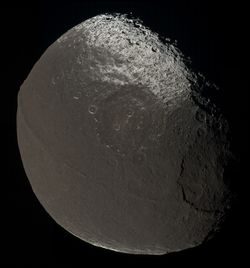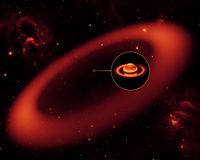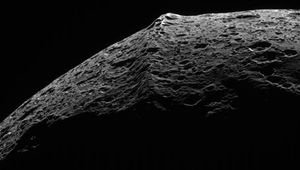اياپتوس (قمر)
 Photomosaic of Cassini images taken Dec. 31, 2004, showing the dark Cassini Regio and its border with the bright Roncevaux Terra, several large craters, and the equatorial ridge | |
| الاكتشاف | |
|---|---|
| اكتشفه | ج. د. كاسيني |
| تاريخ الاكتشاف | October 25, 1671 |
| التسميات | |
| زحل الثامن | |
| الصفات | Iapetian, Japetian |
| السمات المدارية | |
| 3 560 820 كم | |
| Eccentricity | 0.028 612 5[1] |
| 79.321 5 d | |
| Inclination | 17.28° (to the ecliptic) 15.47° (إلى خط إستواء زحل) 8.13° (to Laplace plane) |
| Satellite of | زحل |
| السمات الطبيعية | |
| الأبعاد | 1494.8×1424.8 كم[2] |
نصف القطر المتوسط | 735.60 ± 3 km[2] |
Mean radius | 735.60 ± 3 km[2] |
| 6 700 000 km² | |
| Mass | (1.805 635 ± 0.000 375)×1021 kg[3] |
Mean density | 1.083 0 ± 0.006 6 g/cm³[3] |
| 0.223 m/s2 | |
| 0.572 km/s | |
| 79.321 5 d (synchronous) | |
| zero | |
| Albedo | 0.05-0.5[4] |
| 10.2-11.9[5] | |
اياپتوس (تــُنطـَق /aɪˈæpɨtəs/,[6] or as Greek Ιαπετός), occasionally Japetus (تــُنطـَق /ˈdʒæpɨtəs/),[7]هو ثالث أكبر أقمار زحل، والقمر الحادي عشر في المجموعة الشمسية،[8] واكتشفها جيوڤاني دومنيكو كاسيني عام 1671. ويشتهر اياپتوس بظاهر التلوين ثنائي-اللون، ولكن اكتشف حديثا عن طريق بعثة كاسني خصائص فيزيائي أخرى غير عادية، مثل الإمتداد الاستوائي والذي يمتد حول منتصف القمر.
. . . . . . . . . . . . . . . . . . . . . . . . . . . . . . . . . . . . . . . . . . . . . . . . . . . . . . . . . . . . . . . . . . . . . . . . . . . . . . . . . . . . . . . . . . . . . . . . . . . . . . . . . . . . . . . . . . . . . . . . . . . . . . . . . . . . . . . . . . . . . . . . . . . . . . . . . . . . . . . . . . . . . . . .
الاكتشاف
اكتشفه الفلكي جيوفاني كاسيني سنة 1671م وهو قمر كبير نسبيا يبلغ قطره نحو 1,436 كيلو مترا ومعدل مسافته عن كوكبه الأم نحو 3,561,300 كيلو متر .
الاسم
سمي اياپتوس على اسم اياپتوس تيتان المستمد من الأسطورة اليونانية. ويطلق عليه أيضا اسم زحل الثامن.
الخصائص الفيزيائية
التلوين ثنائي-اللون


يتميز إيابتوس بتفاوت في لمعانه ( وقد لمح مكتشفه كاسيني ذلك أثناء اكتشافه) فمناطقه المختلفة تتفاوت سطوعا وظلمة .فنصف الكرة المواجه لاتجاه حركته المدارية أكثر عتمة خمس مرات من نصف الكرة الاخر . وقد أكدت رحلات فوياجير هذا التفاوت ونحن نعرف ان هناك حفرا في المناطق الساطعة ولا نعرف شيئا مهما عن المناطق المظلمة.
الشكل البيضاوي
الامتداد الاستوائي
درجات الحرارة
المدار
التنقيب
انظر أيضا
المصادر
- ^ Pseudo-MPEC for Saturn VIII
- ^ أ ب Thomas, P. C. (2007). "Shapes of the saturnian icy satellites and their significance". Icarus. 190: 573–584. doi:10.1016/j.icarus.2007.03.012.
{{cite journal}}: Cite has empty unknown parameter:|month=(help); Unknown parameter|coauthors=ignored (|author=suggested) (help) - ^ أ ب Jacobson, R. A. (2006). "The gravity field of the saturnian system from satellite observations and spacecraft tracking data". The Astronomical Journal. 132: 2520–2526. doi:10.1086/508812.
{{cite journal}}: Unknown parameter|coauthors=ignored (|author=suggested) (help); Unknown parameter|month=ignored (help) - ^ Williams, David R. "Saturnian Satellite Fact Sheet". NASA. Retrieved 2007-11-04.
- ^ "Classic Satellites of the Solar System". Observatorio ARVAL. Retrieved 2007-09-28.
- ^ In US dictionary transcription, قالب:USdict.
- ^ JAP-ə-təs. Lassell, William (1848). "Satellites of Saturn". Monthly Notices of the Royal Astronomical Society. 8 (3): 42–43.
{{cite journal}}: Unknown parameter|month=ignored (help) - ^ الأقمار ذات الكتلة الأكبر من اياپتوس هي: قمر الأرض 4 أقمار گليليان, تيتان، ريا، تيتانيا، اوبرون وتريتون. انظر JPLSSD.
- مؤمن, عبد الأمير (2006). قاموس دار العلم الفلكي. بيروت، لبنان: دار العلم للملايين.
{{cite book}}: Cite has empty unknown parameter:|طبعة أولى coauthors=(help)
. . . . . . . . . . . . . . . . . . . . . . . . . . . . . . . . . . . . . . . . . . . . . . . . . . . . . . . . . . . . . . . . . . . . . . . . . . . . . . . . . . . . . . . . . . . . . . . . . . . . . . . . . . . . . . . . . . . . . . . . . . . . . . . . . . . . . . . . . . . . . . . . . . . . . . . . . . . . . . . . . . . . . . . .
وصلات خارجية
- Cassini mission page - Iapetus
- Discussion of Iapetus dated October 2007
- Iapetus Global Maps
- Iapetus Profile by NASA's Solar System Exploration
- The Planetary Society: Iapetus
- Astronomy Picture of the Day article on Iapetus
- Mirror Objects in the Solar System? - refereed article discussing the speculative mirror matter, and Iapetus in this context
- A Moon with a View - Richard C. Hoagland's imaginative discussion of Iapetus's oddities
- New attempts to crack Saturn's 'walnut' moon - equatorial ridge formation theories
- Movie of Iapetus at National Oceanic and Atmospheric Administration








